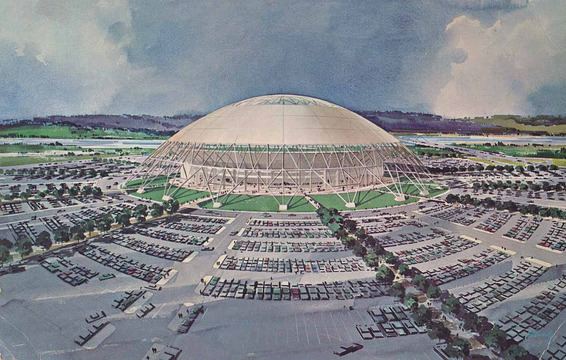Built never built | Broke ground 1964 (designed) Opened 1968 (planned) | |
 | ||
Capacity 46,000 (expandable to 80,000) | ||
Delta Dome was a proposed indoor sports venue in Portland, Oregon.The plans were for a 46,000 seat dome with a plexi-glass skylight and a 17,000 vehicle parking lot. Inspiration came from a similar design in Houston, Texas called the Harris County Domed Stadium (now known as the NRG Astrodome) which was at that time being built.
Contents
Delta Dome was to be built in Delta Park, the location of Vanport City, a housing project for World War II workers, that was destroyed in a 1948 flood when a Columbia River dike failed.
The enclosed stadium was intended to attract a major professional sports franchise, at a time when the city had no professional sports teams.
Delta Dome plans were scrapped after voters rejected two bond measures in 1964. The first rejection was by voters in the City of Portland, a second rejection came when the bond measure was presented to Multnomah County residents. Delta Dome had the support of Mark Hatfield, then Governor of Oregon as well as Portland's then mayor Terry Schrunk. When the city purchased Multnomah Stadium, now known as Providence Park, the push for a covered multi-sports facility ended.
History
The idea for a stadium at Delta Park in Portland, Oregon, was started by a development group in the summer of 1963. They looked at building a domed stadium, similar to the Harris County Domed Stadium in Houston, Texas which was being constructed at the time. Plans were made for a 46,000 seat facility that could be expanded to 80,000 or possibly 100,000. Architects drew up plans for a 17,000 vehicle parking lot. The ceiling of the dome was going to be made from plexi-glass, which would add natural light. The plexi-glass was also supposed to be able to open for ventilation and an open-air feel. If it was approved, the dome was said to be ready to open by 1968. It was estimated to cost US$25 million (US$193.1 million adjusted for inflation).
Measure 2 was on the ballot during Portland's primary election in 1964 which if approved would allow for the construction of the Delta Dome, but it was rejected with 91,961 "yes" votes and 101,324 "no" votes. The Multnomah County Board of Commissioners originally denied the proposed bond in July 1964. The Portland City Council followed suit by rejecting supporters request (by a 4–1 vote) to put it up for a second city-wide approval on August 5, 1964. Governor Mark Hatfield convinced County Commissioner David Eccles to change his vote in favor of the bond in August, which meant it would be voted upon by the citizens of Multnomah County for final approval. In the county-wide contest, it was defeated with 102,281 people voting in its favor and 113,832 voting against.
In March 1965, a bill was introduced into the Oregon House of Representatives which would fund the Delta Dome by imposing a three percent tax on hotels and other forms of lodgings to out-of-state residents. However in November 1965, the City of Portland purchased Multnomah Stadium from the Multnomah Athletic Club putting to rest the city's need for a multi-sports facility.
Opposition
The bond measure ultimately failed, due in part to a sense that Portland could not attract a major sports franchise. The Oregonian noted that the Veterans Memorial Coliseum, which was opened five years before, was hemorrhaging money without a permanent tenant. Another issue raised was the traffic on Interstate 5, which opponents said would get worse if the stadium was erected. As with several civic works projects, opposition grew around the possibility that tax would increase. Worries of flood damage was another concern, since it was in the area that flooded two decades prior.
Supporters
The group funding advertisements in favor of the bond measure was known as "Volunteers for Delta Dome" with Robert Richett as their chairman. A mix-up at the publisher's office led to some of the leaflet advertisements placed in newspapers being switched with anti-President Lyndon B. Johnson material. One of the biggest attractions of the stadium was that it was enclosed, so games would not have to be canceled due to inclement weather. A scale model of the stadium was unveiled in October 1964 where supporters sang a song entitled "New Delta Stadium, Where it Never Rains".
Supporters of the stadium claimed that building a second stadium in Portland would make bids on behalf of the city to the International Olympic Committee more feasible. A consulting firm conducted a study which predicted a US$800,000 profit for the tax base, but it was criticized because it assumed Portland would attract several large events following the completion of the stadium.
After it was voted down in November 1964, there was speculation that the Delta Dome would form a corporation and issue stock for citizens to buy, bypassing the county or city, but the idea never materialized.
